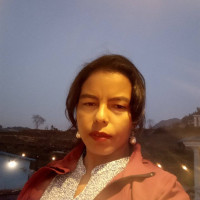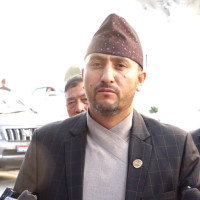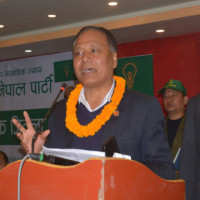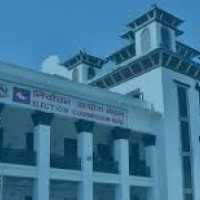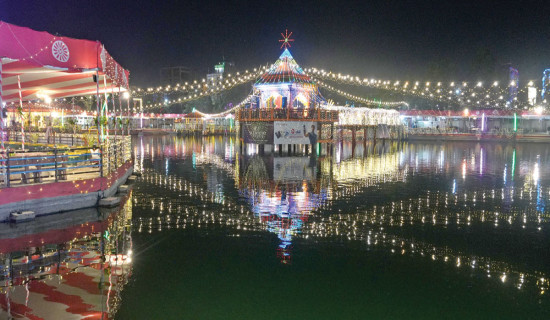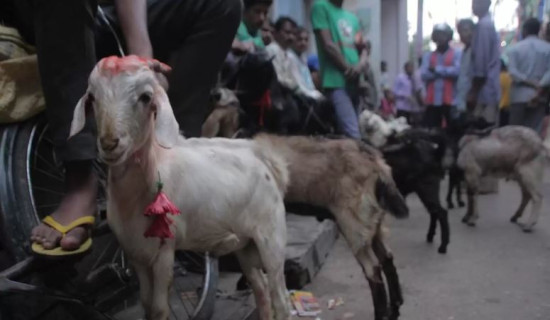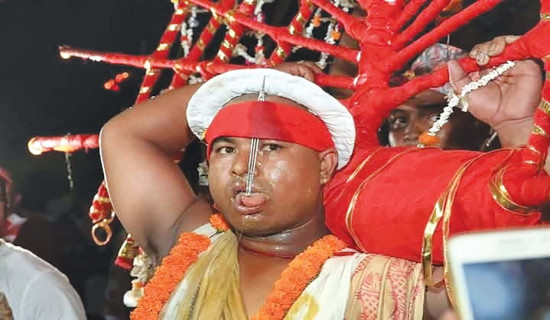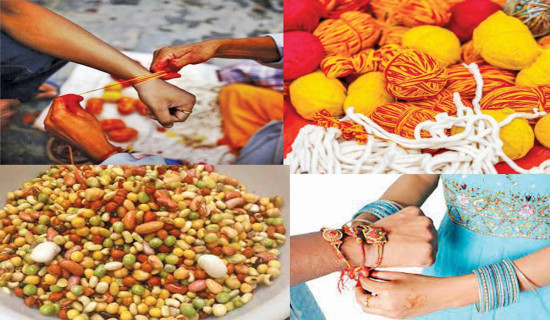- Tuesday, 16 December 2025
Nil Barahi and Mahakali dance come alive in Thimi
Kathmandu, Aug. 14:The narrow alley of Bode and Digu Tole of Madhyapur Thimi will now be covered by the colourful mask dancers for three days from Saturday.
An ancient masked dance of Nil Barahi and Mahakali dance are performed by Newar community of Madhyapur Thimi to preserve the ancient traditional culture.
Every year, the streets of the ancient city of Bhakatpur are flooded with dances of different kinds with the starting of Gai Jatra.
The dancers (Devgan) of the Tha Shrestha of Bode have started rehearsing Nil Barahi Dance, which is performed for four days after the Gai Jatra from Krishna Dwitiya to Panchami.
Prem Chandra Aduwa Shrestha is the main dancer of Nil Barahi dance. At the age of 71, he is going to perform the dance for 64th time this year. The septuagenarian dancer said all the 19 Devgans associated with the Nil Barahi Dance need to perform the dance until their demise.
Of the 19 Devgans, one performs as Bhairav, four as Nil Barahi, four as Kumari, four as Ganesh, four as Singh and two as Dwarpal.
The dance begins and ends at Akha, the sacred spot in Lachhi near the Bode Narayan Temple. The dancers go around several religious shrines located in the Lachhi Tole, Bishnughat Tole, Bhagu Tole, Khasi Tole and the Layaku area.
Once the dance starts in the narrow alley of Bode, the dancers should perform dance 12 to 14 hours a day. They need to follow some street rules during the performance time. They are not allowed to take food, drink water and to talk with anyone and take rest during the whole performance, said Shrestha.
Another traditional Mahakali Dance of Digu Tole, Madhyapur Thimi Municiplaity-5, is being performed for the first time in 80 years. The Prajapati community of Madhyapur Thimi has made efforts to revive the historically and religiously significant dance after 80 years.
The masked dance will be staged for six days after Saparu (Gai Jatra) in the city. The dancers go around the junctions and platforms (Dabalis) of the city.
There are 26 people associated with Mahakali Dance. Of them, 17 are Devgans who dance as various deities.
One performs as the lead Mahakali, one each as Mahalaxmi and Devi, four as Vetals, two as Bhairav, two as Khyak, two as Makas (monkeys) and one each as Singha (lion) and Daitya (demon).
The remaining members play music and carry out other activities to successfully portray the battle between the goddess and the demon Mahisasur through the colourful masked dance, said Samir Sankhadev, dance teacher.
"They have to dance barefoot and once they start, they must not stop – whether there’s rain, wind or even an earthquake," shared Sankhadev.
Believed to have started by King Subarna Malla in the 16th century, the folk dance was last performed in the 1940s and the last house it began from belonged to Kuber Prajapati.
The dancers are not allowed to go home during the dance festival. “They have to sleep at the house from where the dance begins,” he said.
Meanwhile, Patan also held its Mataya festival on Saturday. The festival, where people mainly Buddhist Newas, walk around the historic settlements of Patan, visiting more than 1,700 Hindu and Buddhist shrines and countless Bahals and Bahils, is held every year on the third day of the dark fortnight of Shrawan. However, it was only held symbolically last year and totally cancelled the year before that due to the COVID-19 pandemic. This year though, it was held as normal.
According to the ‘The Wright Chronicle’ by Daniel Wright, a physician who served at the British Residency in Kathmandu from 1866 to 1877, King Gunakamdev started the Mataya festival, also called Nyaku Jatra, and gave the responsibility of organising it every year to 10 localities of Patan, namely Mangal Bazar, Chakrabahil, Ikhachhén, Bubahal, Haugal, Okubahal, Ikhalakhu, Kobahal, Saugal and Nakabahil. To this day, these localities take turns to organise the festival with support from the Nyaku Jatra Mataya Central Management Committee.


